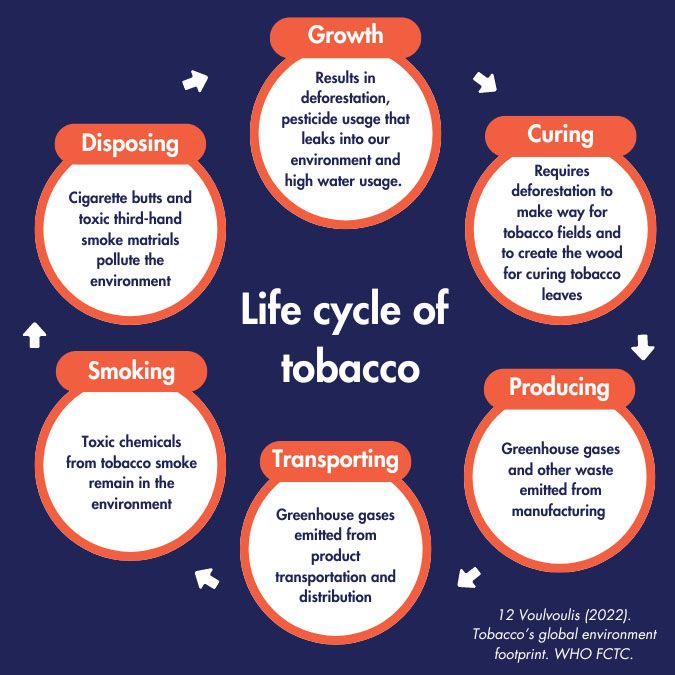
Quit and help the environment too
Did you know cigarettes, rollies and vapes harm the environment? If it’s news to you, you’re not alone. Only about 20% of people know how smoking and vaping harm the environment through production and waste.1
The environmental impact of smoking
Smoking doesn’t only harm your health and the health of those around you. Here’s how it harms the environment too:
To make cigarettes and loose-leaf (rollie) tobacco, tobacco crops must be grown. The harvested tobacco leaves must then be cured before treated and manufactured into cigarettes or rollie tobacco, and then transported for distribution. Once smoked, cigarette butts must be discarded.
The impact is huge, and on a global scale. Each year tobacco and cigarette production right through to disposal results in :
4% of deforestation globally, mostly in low and middle-income countries (as much as 30% of land in some low- and middle-income countries).2
3.2 million hectares of fertile land across 124 countries used to grow deadly tobacco – even in places where people are starving
the use of 22 billion tonnes of water – enough water to fill 15 million Olympic-sized swimming pools3
84 million tonnes of greenhouse gases4
significant use of pesticides
24 billion cigarette butts in Australia alone, which are made from non-biodegradable plastic. 8 billion of these are littered.5

Each individual cigarette requires 3.7 litres of water and creates 14 grams of carbon.2 Altogether, producing tobacco uses 22 billion tonnes of water each year, equivalent to 15 million Olympic- sized swimming pools.3
The environmental impact of vaping
Since the nicotine used in most vapes is sourced from tobacco, Vape production shares many of the same harmful environmental impacts as tobacco production described above.
Vapes also have some unique environmental impacts:
Vapes are usually powered by lithium-ion batteries. These types of batteries can leak chemicals into the environment. They can also explode and cause fires at waste and recycling facilities.6
Vapes create three types of waste: plastic waste from discarded vapes and pods; electronic waste, from the vaping device which includes computer circuits, hard plastics, heavy metals, and batteries; and hazardous chemical waste.
The chemicals from e-liquid containers can't be recycled and the liquid can't be poured down the sink. Speak to your pharmacist about how to dispose of vaping products safely.
Quitting helps you and the environment
Quitting helps your own health and wellbeing as well as the planet’s. By quitting cigarettes and vapes, you help protect forests, conserve precious water, reduce harmful environmental waste, and help to slow climate change by reducing your carbon footprint.
We know quitting can feel hard. Quitting is a journey with ups and downs. Remember, every try counts. Don’t give yourself a hard time if you have a cigarette or vape. You’re still on your quitting journey, and every time you quit you get better at it. Quitline counsellors are here for you wherever you are on your journey. They will help you quit smoking or vaping for good.
Getting in touch with Quitline (13 7848) is a great place to start. Friendly and qualified Quitline counsellors will talk through your reasons for wanting to quit, help identify and manage your triggers and be there for you every step along the way.
There are multiple ways to contact Quitline, including by phone on 13 7848, via the online request a callback form, webchat, WhatsApp and more:
Also check out the free My QuitBuddy app. My QuitBuddy is an app that helps you get, and stay, smoke-free and vape-free. It provides helpful tips and distractions to overcome cravings and tracking systems to chart your progress.
References
1 Tabbakh et al. (2023). Messages about climate, pollution and social justice harms of tobacco as motivators to quit: an untapped communication opportunity? Tobacco Control. Published Online First: 10 January 2024. https://tobaccocontrol.bmj.com/content/early/2024/01/10/tc-2023-058161
2 Lee K, Carrillo Botero N, and Novotny T. ‘Manage and mitigate punitive regulatory measures, enhance the corporate image, influence public policy’: industry efforts to shape understanding of tobacco-attributable deforestation. Globalization and Health, 2016; 12(1):55. Available from: http://dx.doi.org/10.1186/s12992-016-0192-6
3 https://www.who.int/publications/i/item/9789240051287
4 Department of Agriculture Water and the Environment. National plastics plan 2021
5 Cigarette Smoking: An Assessment of Tobacco’s Global Environmental Footprint Across Its Entire Supply Chain. Maria Zafeiridou, Nicholas S Hopkinson, and Nikolaos Voulvoulis. Environmental Science & Technology 2018 52 (15), 8087-8094 DOI: 10.1021/acs.est.8b01533
6 Pourchez et al. (2022). From smoking to vaping: a new environmental threat? The Lancet Respiratory Medicine, 10(7), e63-e64. https://www.thelancet.com/journals/lanres/article/PIIS2213-2600(22)00187-4/fulltext#articleInformation






